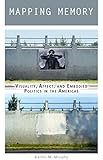Mapping Memory : Visuality, Affect, and Embodied Politics in the Americas / Kaitlin M. Murphy.
Material type: TextPublisher: New York, NY : Fordham University Press, [2018]Copyright date: ©2019Description: 1 online resource (208 p.) : 13Content type:
TextPublisher: New York, NY : Fordham University Press, [2018]Copyright date: ©2019Description: 1 online resource (208 p.) : 13Content type: - 9780823282531
- 9780823282562
- Collective memory -- Political aspects -- Latin America
- Collective memory -- Social aspects -- Latin America
- Visual sociology -- Latin America
- LITERARY CRITICISM / Semiotics & Theory
- Latin America
- Memory
- cultural geography
- documentary film
- human rights
- performance
- photography
- place
- politics
- visual culture
- online - DeGruyter
- Issued also in print.
| Item type | Current library | Call number | URL | Status | Notes | Barcode | |
|---|---|---|---|---|---|---|---|
 eBook
eBook
|
Biblioteca "Angelicum" Pont. Univ. S.Tommaso d'Aquino Nuvola online | online - DeGruyter (Browse shelf(Opens below)) | Online access | Not for loan (Accesso limitato) | Accesso per gli utenti autorizzati / Access for authorized users | (dgr)9780823282562 |
Frontmatter -- contents -- Introduction -- chapter 1. Affect, Haunting, and Memory Mapping -- chapter 2. The Materiality of Memory: Touching, Seeing, and Feeling the Past -- chapter 3. Performing Archives, Performing Ruins -- chapter 4. The Politics of Seeing: Affect, Forensics, and Visuality in the US- Mexico Borderlands -- Conclusion -- Acknowledgments -- Notes -- bibliography -- Index
restricted access online access with authorization star
http://purl.org/coar/access_right/c_16ec
In Mapping Memory, Kaitlin M. Murphy investigates the use of memory as a means of contemporary sociopolitical intervention. Mapping Memory focuses specifically on visual case studies, including documentary film, photography, performance, new media, and physical places of memory, from sites ranging from the Southern Cone to Central America and the U.S.-Mexican borderlands. Murphy develops new frameworks for analyzing how visual culture performs as an embodied agent of memory and witnessing, arguing that visuality is inherently performative. By analyzing the performative elements, or strategies, of visual texts-such as embodiment, reenactment, haunting, and the performance of material objects and places Murphy elucidates how memory is both anchored in and extracted from specific bodies, objects, and places. Drawing together diverse theoretical strands, Murphy originates the theory of "memory mapping", which tends to the ways in which memory is strategically deployed in order to challenge official narratives that often neglect or designate as transgressive certain memories or experiences. Ultimately, Murphy argues, memory mapping is a visual strategy to ask, and to challenge, why certain lives are rendered visible and thus grievable and others not.
Issued also in print.
Mode of access: Internet via World Wide Web.
In English.
Description based on online resource; title from PDF title page (publisher's Web site, viewed 02. Mrz 2022)


